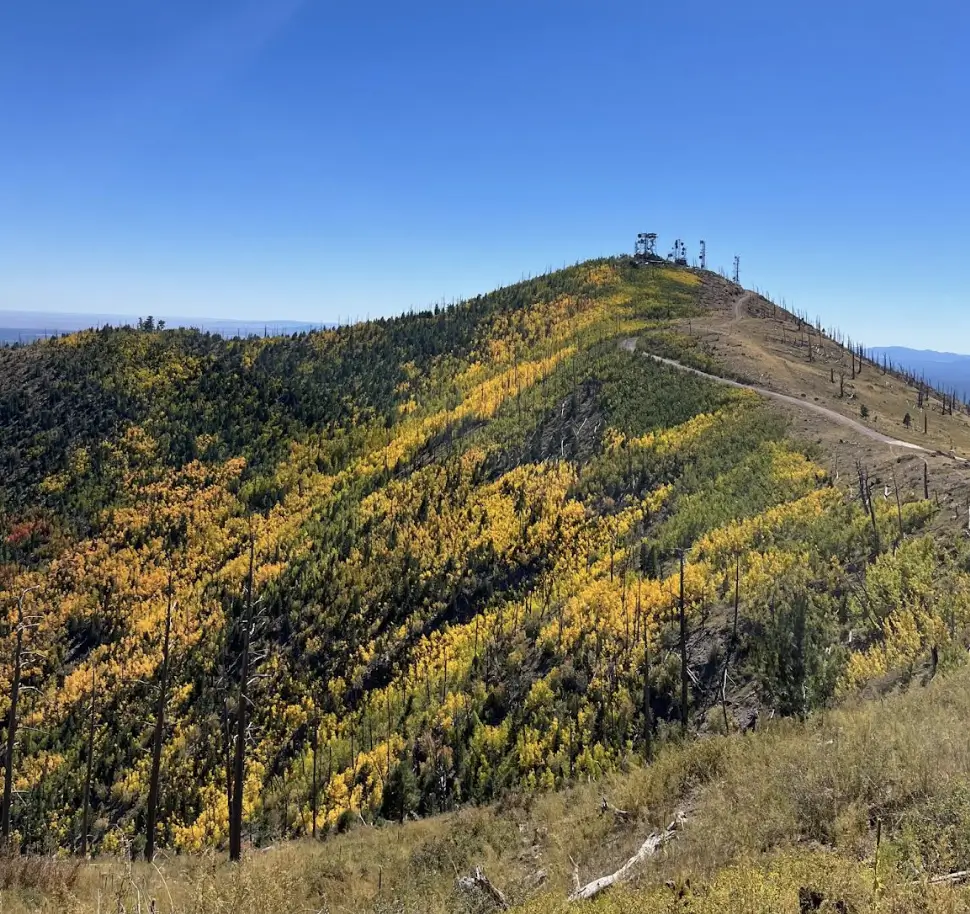Fall Foliage in Flagstaff
Across the higher elevations of Coconino National Forest, autumn is beginning to peer around the corner. The characteristics aspen groves of areas like Mt. Elden, the Kachina Peaks Wilderness, and Kendrick Mountain Wilderness have begun to turn, dotting the forested slopes in shimmering yellows. As temperatures continue to drop and the air becomes crisp, large swaths of fall foliage will punch through the evergreens, transforming the areas around Flagstaff into a tapestry of color.
Whether you’re a Flagstaff local or a visitor to town this October, fall foliage is a spectacle enjoyed by all. Read below for tips on location, timing, and how best to respectfully experience the turning of the seasons in Northern Arizona.
Why do the leaves change color?
The turning of the leaves each autumn is a phenomenon that is widely-loved, yet not widely-understood. During the summer, tree leaves produce large amounts of chlorophyll – a pigment responsible for their green color that also plays a vital role in photosynthesis. But as the weather cools and daylight shortens, chlorophyll production slows to an eventual halt. Because leaves contain other pigments beyond chlorophyll, however, other colors begin to emerge at that time. Different mixtures of fading chlorophyll with other pigments like carotenoids (yellow and orange hues) and anthocyanins (red and purple hues) can lead to many different shades of fall colors in different types of trees. Some trees, like aspens, almost exclusively produce yellow hues during chlorophyll breakdown. Others, like oaks and maples, produce deeper, earthier tones like browns and dark reds.
When do the leaves change in Flagstaff?
Typically, Flagstaff starts seeing leaves change color at the end of September. This, however, can depend on what temperatures are like at the end of the month. Unusually cool temperatures mean the leaves might turn earlier and/or faster, while warmer than average temperatures could delay or slow the process. Colors will continue to change through the month of October, usually peaking around mid-October. A good benchmark for peak fall foliage is Indigenous Peoples’ Day, which is celebrated on the second Monday of the month (this year it is October 14th.)
Best spots to see fall foliage in Flagstaff
Due to the diverse vegetation across Coconino National Forest and Flagstaff’s high elevation, there are many unique areas to experience the unassuming beauty of chlorophyll breakdown. Below are a few of our staff’s favorite spots to take in the fall colors, whether they are hiking, running, camping, or chasing the perfect photo.
- Hart Prairie Road, Kachina Peaks
Located off Highway 180 due west of the Snowbowl, Hart Prairie – or Forest Road 151 – is a scenic drive through the base of the San Francisco Peaks. It can be driven as a loop around the entirety of the Peaks, but the most visited area – which is the best area to see fall colors – is the western stretch between 180 and Snowbowl. Color chasers can take a scenic drive, stop for short hikes and photo opportunities, or even stop at one of the many dispersed camping areas among the aspens for a night or two.
- Lockett Meadow, Inner Basin
Perhaps one of the most famous areas for fall foliage in Flagstaff, Locket Meadow is a beautiful alpine meadow, lined by quaking golden aspens, in the Inner Basin of the San Francisco Peaks. It is accessed from Highway 89A northeast of town; however, it is critical to note that the road that leads all the way up to Lockett Meadow is closed to vehicles due to damage from the Pipeline Fire in 2022. You can still park at the base of the closure and hike or bike the rest of the road, but be prepared for a 6-mile round trip excursion.
- Aspen Corner, Snowbowl Road
As its name suggests, Aspen Corner is a beautiful grove of aspens high up in the San Francisco Peaks. Located just off Snowbowl Road about halfway up to the resort, visitors can easily pull off and take a leisurely stroll through the changing colors. It is an exceptionally kid-friendly hike, making it an ideal place for families visiting the area. It is also a popular spot to hammock.
- West Fork, Oak Creek Canyon
Just south of Flagstaff and north of Sedona lies the beautiful Oak Creek Canyon, a deep chasm of basalt, limestone, and sandstone carved by the rushing waters of Oak Creek. Driving from Flagstaff to Sedona via Oak Creek Canyon provides the unique experience of watching the landscape change from ponderosa pine forest to oak forest and pinyon-juniper woodlands. The magnificent varieties of oak trees in the canyon turn brilliantly in the fall, particularly along the cool waters of the West Fork of Oak Creek. Visitors can hike the West Fork Trail to experience these colors, though be warned that it is a popular hike, meaning it can be crowded and the parking area often fills up early and quickly.
- Sunset Trail, Mt. Elden
The Sunset Trail is a hiking and mountain biking trail that leads up the north aspect of Mount Elden from Schultz Pass Road. It is a beautiful hike through the quintessential ponderosa pine forests of Northern Arizona, and toward the top of Mt. Elden, aspens pop up like flowers blooming in a meadow. These aspens tend to change colors faster and earlier in the season, as the Sunset Trail sees less light and experiences colder temperatures due to being on the north-facing slopes of the mountain. The hike is about 9-miles round trip, so come prepared with snacks, water, and extra layers.
General tips for enjoying fall colors in Flagstaff
- Plan ahead: Check local weather conditions and other outlets – from Forest Service webpages to social media – to tune into what the foliage looks like at the time you are planning to visit. Feel free to give Peace Outfitters a call as well – our staff is always out hiking, running, biking, and camping, and would be more than happy to give you an up-to-date report on the foliage.
- Timing is key: Timing doesn’t necessarily mean when in the year to find fall colors – it also means when during each day is best to see them. Early morning and late afternoon (golden hour) offer the best lighting to experience fall foliage in all their splendor.
- Layer up: Fall in Northern Arizona is a season of extremes. During the day, temperatures can still swell into the 80s at times; yet in the morning and evening, they can dip down into the 30s and 40s. This means that it is crucial to bring extra layers, especially if you plan on hiking in the mornings or evenings or camping overnight.
- Practice Leave No Trace: as always, remember to practice Leave No Trace principles when recreating during fall foliage season. Pack out any trash you produce while out hiking and camping, only camp on durable surfaces or pre-established sites, and respect other recreationists who are out looking to experience the colors of fall as well.
Fall foliage in Flagstaff, Arizona, is a stunning seasonal phenomenon that shouldn’t be missed. With its stunning views and vibrant colors, the area offers a perfect backdrop for all manner of outdoor activities among the aspens and oaks, from long trail runs to casual family picnics in the shade. If you’re planning to head to any of these spots – or others you may know of – let us know. Or, if you’re looking for a nice area to experience fall colors, swing by the store and let are staff point you toward our maps and guidebooks to get you on your way. See you out there!

